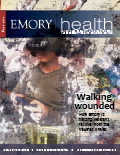Like going to the dentist, but for the voice
 |
Daryl Collins never knew what sounds would emerge when he began to speak. His hoarseness made him so self-conscious that he went looking for a cure.
The cause, he discovered, was recurring growths on his vocal cords, most likely tied to papillomavirus.
So Collins underwent direct laryngoscopy, a surgical procedure requiring general anesthesia. When the growths again grew large enough to affect his cords, he underwent the procedure again and again and again—in fact, three times a year for seven years.
Then Collins learned about a procedure at the Emory Voice Center that allows doctors to remove the growths without putting patients to sleep. “This was something I had been looking for for years,” he says. “I don’t relish having to be put to sleep every two to three months.”
The Emory Voice Center is one of a few in the nation and the first one in the Southeast that offers awake laser therapy. Introduced at Emory in 2007, the approach uses a potassium titanyl phosphate (KTP) laser to avoid damaging the delicate tissues of the vocal folds during surgery. Its predecessor, the pulsed dye laser, was developed to treat port-wine stains caused by broken blood vessels.
KTP has since received FDA approval as a treatment for vocal disorders and is regularly covered by most insurance plans. Most recently, its use has been expanded as a trial treatment for laryngeal cancer in combination with anti-cancer therapies such as radiation and chemotherapy.
“The laser basically starves a lesion by heating and shutting down the blood vessels that feed it,” says Emory laryngologist Adam Klein.
According to Klein, awake laser therapy is ideal for patients with recurring conditions—such as papilloma and dysplasia—because it does less damage than conventional surgery to surrounding tissue and can be performed as an outpatient procedure.
“We can keep patients healthy without putting them to sleep over and over again,” Klein says.
The treatment requires only local anesthesia, poses minimal risk of damage to vocal cord tissue, and takes only a couple of minutes to do. It involves numbing the throat and running an endoscope down through the nose to view the larynx and vocal cords. Doctors then snake a flexible laser through the endoscope to treat the problem, while the patient remains awake.
“I was a little nervous the first time that Dr. Klein treated me with the pulsed KTP laser,” Collins says. “But once the numbing agent kicked in, it really wasn’t that bad. In fact, after the numbness goes away, there’s no residual pain. Except for the fact that a couple of days later my voice returns and sounds a lot better, I don’t even notice that he’s been there.” —Quinn Eastman
|
Web Connection: To see a video on the awake laser therapy for the voice, visit bit.ly/voicetherapylaser. |


